A Legacy of Faith
The History of Our Diocese
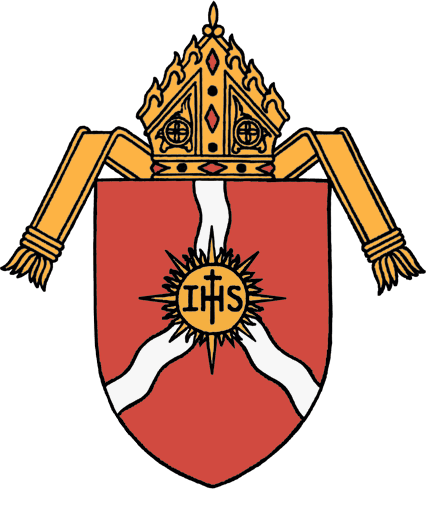
The Shield of Our Diocese
The shield of the Diocese of Shreveport is composed of a red field to represent the Red River that runs through the See City. On this red field – is a gold sunburst charged with the monogram of the Holy Name (IHS). This symbolism is employed here to represent Saint John Berchmans, titular of the Cathedral Church. From the sunburst issue three wavy bars to represent the three rivers that run through the diocese–the Red, the Mississippi, and the Ouachita–and to represent the waters of Baptism that flow from God, Our Father, to save all mankind.
The Diocese of Shreveport
The Diocese of Shreveport, the seventh Catholic Diocese in Louisiana, was established by Pope John Paul II June 16, 1986. The Most Reverend William B. Friend was named as the first Bishop with the ceremony of installation held July 30, 1986, in the Cathedral of St. John Berchmans. The retirement of Bishop Friend was accepted by the Vatican effective December 2006. Bishop William Benedict Friend departed this life on April 2, 2015, and was laid to rest in the Prayer Garden he established at the Cathedral of St. John Berchmans. On April 1, 2008, the Holy Father appointed Msgr. Michael G. Duca, a priest of the Diocese of Dallas, as second Bishop of Shreveport. His ordination and installation took place on May 19, 2008. Bishop Michael G. Duca was installed as the 16th Bishop of the Diocese of Baton Rouge on August 24, 2018. Very Reverend Peter B. Mangum was elected Diocesan Administrator by the College of Consultors on August 27, 2018. After 17 months, Archbishop Christophe Pierre, on behalf of Pope Francis, announced the appointment of Msgr. Francis I. Malone, of the Diocese of Little Rock, as the third Bishop of the Diocese of Shreveport. Msgr. Malone was ordained and installed as Bishop of Shreveport on January 28, 2020.
The first diocesan offices were located in the Catholic Center at 2500 Line Avenue. In July 1999 the diocese acquired a property known as the St. Vincent Convent and Academy which had formerly served as the Motherhouse and educational institution of the Daughters of the Cross. This property, located at 3500 Fairfield Avenue, has served as a physical sign of the presence of the Catholic Church in this area since 1866. The facility includes a residence for the diocesan bishop and other clergy, a Catholic conference center and the diocesan ministerial and administrative offices known as the Catholic Center. The renovated diocesan offices were operational in late May 2000.
The Shreveport diocese covers 11,200 square miles and is comprised of the 16 northernmost civil parishes in the state, Bienville, Bossier, Caddo, Claiborne, DeSoto, East Carroll, Jackson, Lincoln, Morehouse, Ouachita, Red River, Richland, Sabine, Union, Webster, and West Carroll. The area that makes up the Diocese of Shreveport was administered by the Diocese of Natchitoches beginning in 1853, was redesignated the Diocese of Alexandria in 1910 and the Diocese of Alexandria-Shreveport in 1977.
St. John Berchmans was designated the Cathedral Church in June 1986 with the establishment of the diocese. It is the second oldest parish in the city of Shreveport. Established in 1902 by the Jesuit Order at the request of Bishop Anthony Durier, the Cathedral is named in honor of the saint credited with restoring health to a dying nun in Grand Coteau, Louisiana. A complete restoration of the interior was performed beginning in 1992, and on August 28, 1993, the Cathedral of St. John Berchmans was rededicated.
Early History
The work of the Church in northern Louisiana began in earnest with the establishment of the Diocese of Natchitoches in 1853. Prior to that time missionaries made sporadic efforts to bring the Church to the native peoples of the area and to the French and Spanish settlers. The establishment of Fort John Baptiste in 1716 near the present city of Natchitoches and the strong support given to the Church by French officials aided the missionary efforts. With the acquisition of Louisiana by Spain in 1769, it became difficult to obtain clergy to minister on a permanent basis. Between 1795 and 1798, however, the Spanish had established two chapels within the current boundaries of the Diocese of Shreveport.
From 1801 until 1815, the growth of the Church suffered due to the uncertainty of Spanish rule and land disputes between Spain and the United States. The Church concentrated its work in south Louisiana with its large Catholic population. Northern Louisiana contained approximately 20,000 Catholics scattered over an area equal to about three-fifths of the present state. Funding was inadequate to support the number of clergy required in a large area with poor transportation facilities. At the chapel near Monroe, no priest ministered for over 20 years. During the 1840s the Lazarist Fathers visited chapels in the extreme northern part of Louisiana but abandoned this work in 1849. At this point the Bishop of New Orleans formed the deanery of Natchitoches for most of north Louisiana to assist in providing more priests for the area.
The Diocese of Natchitoches Erected
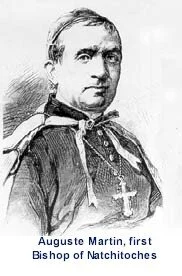 In 1853, in response to the need to serve the Catholics of north Louisiana, the Diocese of Natchitoches was erected, and Auguste Marie Martin was appointed first Bishop. The newly created diocese had five priests to serve its vast territory. Obtaining funds and clergy to serve the diocese was a major endeavor of Bishop Martin. Native vocations were scarce, but the French clergy responded generously to the call to serve in the missionary diocese. The Society for the Propagation of the Faith responded also by providing much needed funding. Catholic education was a priority, but it was difficult to obtain religious to serve as teachers. The Daughters of the Cross responded to the need for teaching sisters with the American foundation of the Order in Avoyelles Parish in 1855. Ten years later the congregation established their motherhouse at Shreveport. The Sacred Heart Sisters, Sisters of Mercy and Benedictine Fathers also served the diocese but left upon Bishop Martin’s death.
In 1853, in response to the need to serve the Catholics of north Louisiana, the Diocese of Natchitoches was erected, and Auguste Marie Martin was appointed first Bishop. The newly created diocese had five priests to serve its vast territory. Obtaining funds and clergy to serve the diocese was a major endeavor of Bishop Martin. Native vocations were scarce, but the French clergy responded generously to the call to serve in the missionary diocese. The Society for the Propagation of the Faith responded also by providing much needed funding. Catholic education was a priority, but it was difficult to obtain religious to serve as teachers. The Daughters of the Cross responded to the need for teaching sisters with the American foundation of the Order in Avoyelles Parish in 1855. Ten years later the congregation established their motherhouse at Shreveport. The Sacred Heart Sisters, Sisters of Mercy and Benedictine Fathers also served the diocese but left upon Bishop Martin’s death.
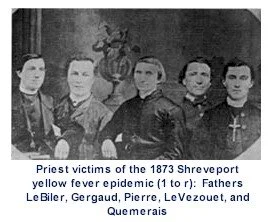 Martin encouraged the establishment of priest schools at each church. These schools consisted of Catholic lay teachers and the priest educating young boys in the rectory. Such schools existed in Shreveport, Monroe and Lake Providence. In 1870 the diocese boasted 25 churches and 17 priests. However, yellow fever struck Shreveport in 1873, and five priests lost their lives in the service of others. Bishop Martin died in 1875, and the See was vacant for nearly two years. Bishop Francis X. Leray was consecrated the second Bishop of Natchitoches in 1877. In 1879 he was appointed coadjutor of New Orleans, and the majority of his time was spent then with the affairs of the Archdiocese. It was a difficult time for the Diocese of Natchitoches. In 1883 Leray advanced to the position of Archbishop of New Orleans. He appealed to Rome to be relieved of north Louisiana and two years later Anthony Durier was consecrated the third Bishop of Natchitoches.
Martin encouraged the establishment of priest schools at each church. These schools consisted of Catholic lay teachers and the priest educating young boys in the rectory. Such schools existed in Shreveport, Monroe and Lake Providence. In 1870 the diocese boasted 25 churches and 17 priests. However, yellow fever struck Shreveport in 1873, and five priests lost their lives in the service of others. Bishop Martin died in 1875, and the See was vacant for nearly two years. Bishop Francis X. Leray was consecrated the second Bishop of Natchitoches in 1877. In 1879 he was appointed coadjutor of New Orleans, and the majority of his time was spent then with the affairs of the Archdiocese. It was a difficult time for the Diocese of Natchitoches. In 1883 Leray advanced to the position of Archbishop of New Orleans. He appealed to Rome to be relieved of north Louisiana and two years later Anthony Durier was consecrated the third Bishop of Natchitoches.
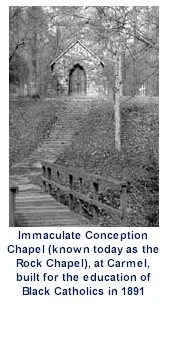 An important contribution of Bishop Leray was his mandate that all religious instruction including prayers, sermons, educational training be given in English. Up to this time French was the language used by the clergy and religious in the area, whereas the native population spoke English. During the administration of Bishop Durier and his successors, the diocese entered a period of growth and relative prosperity. Appointed in 1885 Bishop Anthony Durier was the first bishop to use pastoral letters to communicate regularly with the faithful. These letters were read aloud in every church, then printed and distributed to the people. Like Bishop Martin, Durier focused his efforts on improving Catholic education. His first pastoral letter directed that a Catholic school be established near every church. He organized the first Catholic school board in Louisiana in the year 1889. This board is credited with increasing the number of schools in the diocese from four in 1885 to 23 in 1904. Five of these schools offered children of color the opportunity to receive a Catholic education. During the administration of Bishop Durier (1885-1904), six new parishes and a number of mission chapels were established. Included among the new parishes was St. John Berchmans, now the Cathedral parish of the Diocese of Shreveport.
An important contribution of Bishop Leray was his mandate that all religious instruction including prayers, sermons, educational training be given in English. Up to this time French was the language used by the clergy and religious in the area, whereas the native population spoke English. During the administration of Bishop Durier and his successors, the diocese entered a period of growth and relative prosperity. Appointed in 1885 Bishop Anthony Durier was the first bishop to use pastoral letters to communicate regularly with the faithful. These letters were read aloud in every church, then printed and distributed to the people. Like Bishop Martin, Durier focused his efforts on improving Catholic education. His first pastoral letter directed that a Catholic school be established near every church. He organized the first Catholic school board in Louisiana in the year 1889. This board is credited with increasing the number of schools in the diocese from four in 1885 to 23 in 1904. Five of these schools offered children of color the opportunity to receive a Catholic education. During the administration of Bishop Durier (1885-1904), six new parishes and a number of mission chapels were established. Included among the new parishes was St. John Berchmans, now the Cathedral parish of the Diocese of Shreveport.
The Diocese of Alexandria
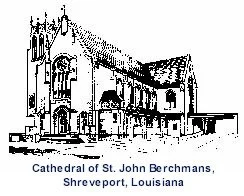 During his 12 year tenure (1933-1945), 26 new parishes were erected and 35 new churches were built. He invited the Franciscan Friars to the diocese to help staff this increased number of parishes. Other accomplishments included the creation of a Catholic Charities office, initiation of a diocesan-wide fund raising campaign, appointment of a diocesan superintendent of schools and establishment of ten new schools. Bishop Charles P. Greco governed our north Louisiana diocese for 27 years (1946-1973). Under his leadership a phenomenal building program was undertaken including the construction of over 450 churches, chapels, schools, convents, rectories and diocesan buildings. He took pride in the two homes he founded for special children. The Holy Father accepted Bishop Greco’s retirement in 1973, and Lawrence P. Graves became the Bishop of Alexandria, serving until his retirement in 1982.
During his 12 year tenure (1933-1945), 26 new parishes were erected and 35 new churches were built. He invited the Franciscan Friars to the diocese to help staff this increased number of parishes. Other accomplishments included the creation of a Catholic Charities office, initiation of a diocesan-wide fund raising campaign, appointment of a diocesan superintendent of schools and establishment of ten new schools. Bishop Charles P. Greco governed our north Louisiana diocese for 27 years (1946-1973). Under his leadership a phenomenal building program was undertaken including the construction of over 450 churches, chapels, schools, convents, rectories and diocesan buildings. He took pride in the two homes he founded for special children. The Holy Father accepted Bishop Greco’s retirement in 1973, and Lawrence P. Graves became the Bishop of Alexandria, serving until his retirement in 1982.
The episcopacy of Bishop Graves fostered the growth of the post-Vatican Council Church within the diocese. Programs established or expanded during his administration included communications, the annual Diocesan Service Appeal, priests’ continuing education, the diocesan office of religious education and youth ministry, the permanent diaconate, and the formation of deanery pastoral councils. To recognize the growing population of northwest Louisiana, the Diocese of Alexandria officially became known as the Diocese of Alexandria-Shreveport in 1977, with St. John Berchmans Church serving as Co-Cathedral. In January 1983 William B. Friend was consecrated Bishop of Alexandria-Shreveport, the largest Louisiana diocese in terms of square miles. It is from this background that the Diocese of Shreveport emerged three years later.
Historical Timeline
1692
1699
1716
1717
1721
1728-1734
1734-1738
c.1760
1769-1774
1795
1796
1806-1838
1817
1829
1831
1849
1851
1853-1857
1854-1855
Missionaries from southeast Texas and Natchitoches Civil Parish began to visit Bayou Pierre in DeSoto Civil Parish, Shreveport, and communities near present Bossier City, Athens, and Minden
1855
Priest sent to establish parish near Carmel on Bayou Pierre in DeSoto Civil Parish; Left to found Shreveport church DeSoto Civil Parish Catholic Church served sporadically from Natchitoches
1856
Priests sent to reside in Monroe and Shreveport
